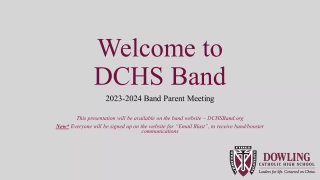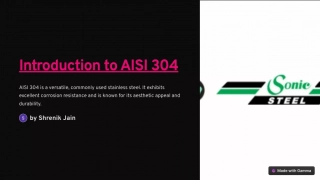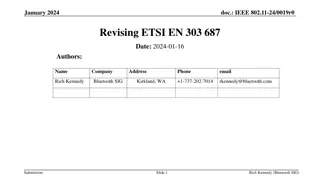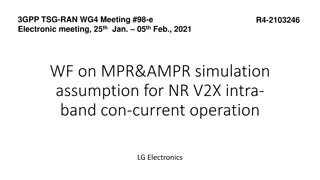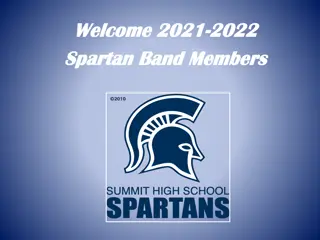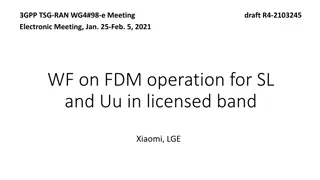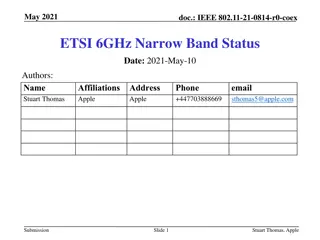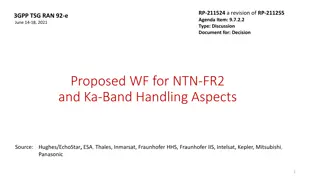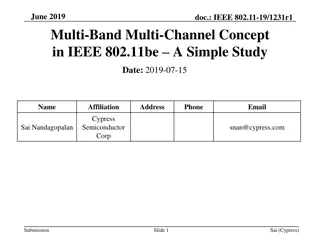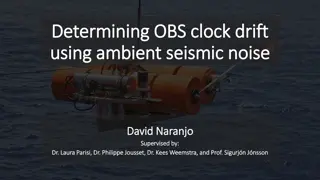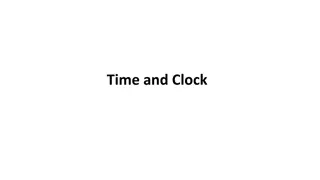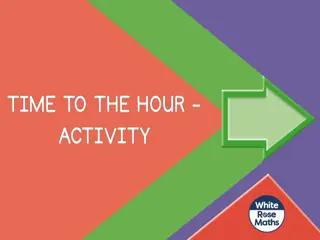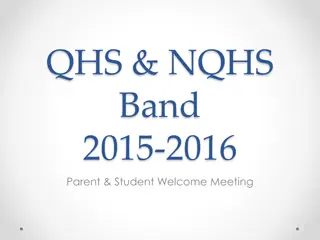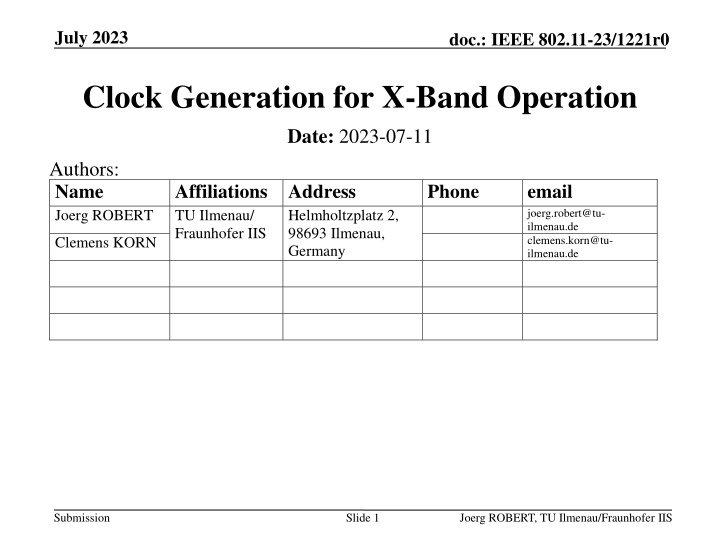
Clock Generation for X-Band Operation in IEEE 802.11-23
Explore a presentation on clock generation for X-band operation in IEEE 802.11-23, focusing on the generation of the 2.4 GHz clock signal from sub-GHz signals. The implementation of an Integer-N-PLL for generating the 2.4 GHz signal is discussed, showcasing its ability to operate in various sub-GHz bands globally. The hardware realization of the X-band concept and details on the demodulator used are also provided in the submission slides.
Download Presentation

Please find below an Image/Link to download the presentation.
The content on the website is provided AS IS for your information and personal use only. It may not be sold, licensed, or shared on other websites without obtaining consent from the author. If you encounter any issues during the download, it is possible that the publisher has removed the file from their server.
You are allowed to download the files provided on this website for personal or commercial use, subject to the condition that they are used lawfully. All files are the property of their respective owners.
The content on the website is provided AS IS for your information and personal use only. It may not be sold, licensed, or shared on other websites without obtaining consent from the author.
E N D
Presentation Transcript
July 2023 doc.: IEEE 802.11-23/1221r0 Clock Generation for X-Band Operation Date: 2023-07-11 Authors: Name Joerg ROBERT Affiliations Address TU Ilmenau/ Fraunhofer IIS Phone email joerg.robert@tu- ilmenau.de clemens.korn@tu- ilmenau.de Helmholtzplatz 2, 98693 Ilmenau, Germany Clemens KORN Submission Slide 1 Joerg ROBERT, TU Ilmenau/Fraunhofer IIS
July 2023 doc.: IEEE 802.11-23/1221r0 Abstract There were questions on the generation of the 2.4 GHz clock out of the sub-GHz signal in 11-23/867r0, slide 14. The idea is to receive sub-GHz signals on the downlink and use them for 2.4 GHz signals on the uplink. This presentations shows an exemplary implementation of the Integer-N-PLL for the generation of the 2.4 GHz signal out of the sub-GHz signal. The presentation shows that the proposed system is able to operate in all relevant sub-GHz bands (US, Europe, China, etc.) Submission Slide 2 Joerg ROBERT, TU Ilmenau/Fraunhofer IIS
July 2023 Possible Hardware-Realization of X-band Concept doc.: IEEE 802.11-23/1221r0 RX Antenna Uplink Data ????? N Demodulator OOK Decoder Microcontroller Main Divider Phase Detector Loop filter Charge pump VCO RF Modulator R up/ down ?1 (2.4 GHz) ????? Reference Divider ???? ?2 sub-GHz Integer-N PLL TX Antenna The signal frequency of the AMP-assisting STA provides the reference clock (ideally sub-GHz) The signaling in the downlink signal to the AMP STA indicates the actual signal frequency An Integer-N-PLL creates the TX frequency of the AMP STA using the aforementioned information No expensive and power-hungry crystal oscillator needed VCO: Voltage Controlled Oscillator OOK: On-off-keying Submission Slide 3 Joerg ROBERT, TU Ilmenau/Fraunhofer IIS
July 2023 doc.: IEEE 802.11-23/1221r0 Demodulator The AMP STA demodulator is comparable to a demodulator used in the UHF-RFID standard since 2004 [2] The very high bandwidth of 860-960 MHz supports operation in all ITU regions, no additional filters are used Loss due to high noise is compensated due to high reception powers (anyhow required for energy supply) The modulation uses OOK for highly power efficient decoding Submission Slide 4 Joerg ROBERT, TU Ilmenau/Fraunhofer IIS
July 2023 doc.: IEEE 802.11-23/1221r0 Integer-N PLL ????? N Main Divider Phase Detector Loop Filter Charge pump ?1(2.4 GHz) VCO up/ down R ????? Reference Divider ???? ?2(sub-GHz) Integer-N PLL - Frequency dividers: - ?????=?2 - ????=?1 - N and R can either be calculated by the microcontroller or stored in a look-up table - After the PLL settling only the VCO has to stay on to further reduce the power consumption Slide 5 ? => ?1= ?2 ? ? ? Submission Joerg ROBERT, TU Ilmenau/Fraunhofer IIS
July 2023 doc.: IEEE 802.11-23/1221r0 Determining the PLL Dividers CHNL ID Channel Freq (MHz) N R Frequency Deviation in Hz Deviation in ppm 1 2412 847 304 329 0.1 2 2417 2778 995 402 0.2 3 2422 1978 707 849 0.4 4 2427 2554 911 878 0.4 5 2432 1694 603 332 0.1 6 2437 3364 1195 167 0.1 7 2442 2220 787 0 0 8 2447 5820 2059 486 0.2 9 2452 2501 883 340 0.1 10 2457 4209 1483 202 0.1 11 2462 4647 1634 61 0 12 2467 2522 885 452 0.2 13 2472 8655 3031 495 0.2 14 2484 1779 620 484 0.2 Example for ??= ???.? MHz (European RFID frequency) Smaller N and R are possible for even faster PLL settling times Similar table are available for all sub-GHz bands (US, Europe, China) Submission Slide 6 Joerg ROBERT, TU Ilmenau/Fraunhofer IIS
July 2023 doc.: IEEE 802.11-23/1221r0 Benefits of X-Band Operation - Minimized on-air times in the 2.4 GHz band - Energizer and slow OOK downlink use existing RFID bands ( fits to existing frequency regulation) - The frequencies are supported by state-of-the-art smartphones - No actual full-duplex requirement in AMP-assisting STA - RX of AMP STA comparable to current UHF-RFID proven and simple energy-efficient technology Submission Slide 7 Joerg ROBERT, TU Ilmenau/Fraunhofer IIS
July 2023 doc.: IEEE 802.11-23/1221r0 Conclusions This presentation shows a method to generate the 2.4 GHz frequency out of any sub-GHz frequency using an Integer-N-PLL The concept is low cost and low power as no crystal oscillators are required No full duplex operation is required for the AMP- assisting STA The proposed system is covered by existing frequency regulation Submission Slide 8 Joerg ROBERT, TU Ilmenau/Fraunhofer IIS
July 2023 doc.: IEEE 802.11-23/1221r0 Literature [1] Behzad Razavi, RF Microelectronics , Prentice Hall [2] EPC Radio-Frequency Identity Protocols Generation-2 UHF RFID Standard, 2018, https://www.gs1.org/sites/default/files/docs/epc/gs1-epc- gen2v2-uhf-airinterface_i21_r_2018-09-04.pdf Submission Slide 9 Joerg ROBERT, TU Ilmenau/Fraunhofer IIS

